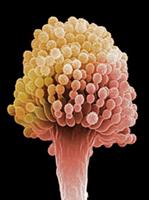
Mold in Residential and Commercial Structures
| Call or email for pricing or with any questions: 858-688-2868 jeff@sandiegotesting.com |
Although there currently are no regulations covering mold exposure, excessive inhalation of mold spores is
considered unhealthy by virtually every medical authority and government agency that has studied exposure
(including the California Department of Public Health, and EPA). Failure at creating regulations is primarily due
to technical difficulties in creating a permissible exposure limit (PEL) for a contaminant that has hundreds of
different species commonly found indoors with varying degrees of health effects.
considered unhealthy by virtually every medical authority and government agency that has studied exposure
(including the California Department of Public Health, and EPA). Failure at creating regulations is primarily due
to technical difficulties in creating a permissible exposure limit (PEL) for a contaminant that has hundreds of
different species commonly found indoors with varying degrees of health effects.
To survive, mold requires moisture, oxygen, and organic material to feed on (wood, paper, dust, carpeting, etc.).
The presence of mold indicates that there is a moisture problem somewhere indoors which could include roof
leaks, foundation leaks, window condensation, pipe leaks, and excess humidity caused by poor ventilation. In
order to permanently remove mold, the moisture problem must be identified and corrected. To a lesser extent
dust control will also help keep mold away in some circumstances.
The presence of mold indicates that there is a moisture problem somewhere indoors which could include roof
leaks, foundation leaks, window condensation, pipe leaks, and excess humidity caused by poor ventilation. In
order to permanently remove mold, the moisture problem must be identified and corrected. To a lesser extent
dust control will also help keep mold away in some circumstances.
Identifying Moisture Problems
Indoor moisture problems fall into two categories:
obvious and unobvious. Obvious moisture problems
such as flooding or a leaky drain pipe under the sink
do not require a professional investigation but may
require professional remediation.
obvious and unobvious. Obvious moisture problems
such as flooding or a leaky drain pipe under the sink
do not require a professional investigation but may
require professional remediation.
Mold Sampling
Types of samples include air samples, surface samples, and bulk samples (chunks of
carpet, insulation, wallboard, etc.). The analysis should follow analytical methods
recommended by the American Industrial Hygiene Association (AIHA), the American
Conference of Governmental Industrial Hygienists (ACGIH), or other professional
guidelines.
carpet, insulation, wallboard, etc.). The analysis should follow analytical methods
recommended by the American Industrial Hygiene Association (AIHA), the American
Conference of Governmental Industrial Hygienists (ACGIH), or other professional
guidelines.
Toxic Mold
All molds have the potential to cause health
effects, most commonly by triggering allergic
reactions. Some species of mold including
Aspergillus and Stachybotrys varieties can
cause much more severe health problems.
These molds produce toxic substances
called mycotoxins. Exposure pathways for
mycotoxins can include inhalation, ingestion,
or skin contact. Fortunately, these types of
mold are not commonly found indoors.
effects, most commonly by triggering allergic
reactions. Some species of mold including
Aspergillus and Stachybotrys varieties can
cause much more severe health problems.
These molds produce toxic substances
called mycotoxins. Exposure pathways for
mycotoxins can include inhalation, ingestion,
or skin contact. Fortunately, these types of
mold are not commonly found indoors.
Unobvious moisture problems such as poor ventilation,
pipe leak inside a wall, and roof and foundation leaks
often necessitate a professional investigation by a
company such as San Diego Testing. In such cases
the occupants may notice a mold odor without seeing
the actual mold.
pipe leak inside a wall, and roof and foundation leaks
often necessitate a professional investigation by a
company such as San Diego Testing. In such cases
the occupants may notice a mold odor without seeing
the actual mold.
mold hidden inside wall
In most cases, if visible mold growth is present, sampling is unnecessary - fix the moisture problem, remove the
mold, and the project is done. However, in specific instances, such as cases where litigation is involved, the
source(s) of the mold contamination is unclear, or health concerns are a problem, sampling may be useful as
part of a site evaluation. Sampling may also be useful in order to determine if an area has been adequately
cleaned or remediated and many remediation companies and property owners want clearance sampling to verify
that the work has been adequately completed.
mold, and the project is done. However, in specific instances, such as cases where litigation is involved, the
source(s) of the mold contamination is unclear, or health concerns are a problem, sampling may be useful as
part of a site evaluation. Sampling may also be useful in order to determine if an area has been adequately
cleaned or remediated and many remediation companies and property owners want clearance sampling to verify
that the work has been adequately completed.

air sample pump

Aspergillus mold spore
Stachybotrys mold spore

| Lead - Asbestos - Mold Experts in San Diego |
